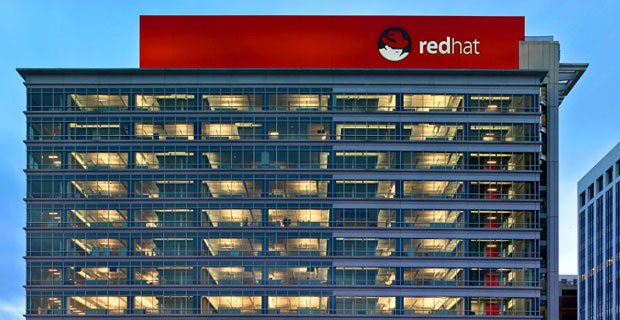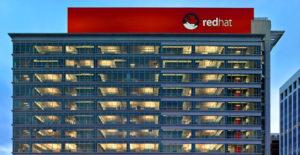The cloud computing landscape may look much different to enterprise users following the announcement earlier this week of IBM’s agreement to acquire Red Hat.
IBM plans to purchase Red Hat, a major provider of open source cloud software, for US$34 billion. IBM will acquire all of the issued and outstanding common shares of Red Hat for $190 per share in cash, under terms of the deal. That stock purchase represents a total enterprise value of approximately $34 billion.
Once the acquisition is finalized, Red Hat will join IBM’s Hybrid Cloud team as a distinct unit, preserving the independence and neutrality of Red Hat’s open source development heritage and commitment, current product portfolio, and go-to-market strategy, plus its unique development culture.
Red Hat president and CEO Jim Whitehurst will continue in his leadership role, as will the other members of Red Hat’s current management team. Whitehurst also will join IBM’s senior management team, reporting to CEO Ginni Rometty. IBM intends to maintain Red Hat’s headquarters, facilities, brands and practices.
Following the acquisition, IBM will remain committed to Red Hat’s open governance, open source contributions, and participation in the open source community and development model.
IBM also will foster Red Hat’s widespread developer ecosystem. In addition, both companies will remain committed to the continued freedom of open source via such efforts as Patent Promise, GPL Cooperation Commitment, the Open Invention Network and the LOT Network.
The acquisition was a smart business move for both IBM and Red Hat, said Charles King, principal analyst at Pund-IT.
“It seems possible or likely that other vendors would be interested in purchasing Red Hat,” he told the E-Commerce Times. “By making a deal happen, IBM is bringing in-house a raft of technologies, solutions and assets that are both familiar and highly complementary to its own solutions.
Partnerships and Financial Oversight
Both IBM and Red Hat will continue to build and enhance Red Hat partnerships. These include the IBM Cloud and other major cloud providers such as Amazon Web Services, Microsoft Azure, Google Cloud and Alibaba. At the same time, Red Hat will benefit from IBM’s hybrid cloud and enterprise IT scale in helping expand its open source technology portfolio to businesses globally.
Partnerships between the two companies span 20 years. IBM served as an early supporter of Linux, collaborating with Red Hat to help develop and grow enterprise-grade Linux and more recently to bring enterprise Kubernetes and hybrid cloud solutions to customers.
These innovations have become core technologies within IBM’s $19 billion hybrid cloud business. Between them, IBM and Red Hat have contributed more to the open source community than any other organization, the companies noted.
“For Red Hat, IBM is an ideal partner to help the company scale its business to the next level. Really, no other vendor comes close to having IBM’s reach into and credibility among global enterprises,” said King.
IBM intends to close the transaction through a combination of cash and debt in the latter half of next year. The acquisition has been approved by the boards of directors of both IBM and Red Hat.
The deal is subject to Red Hat shareholder approval. It also is subject to regulatory approvals and other customary closing conditions.
IBM plans to suspend its share repurchase program in 2020 and 2021. The company expects to accelerate its revenue growth, gross margin and free cash flow within 12 months of closing.
Moving Forward
“The acquisition of Red Hat is a game-changer. It changes everything about the cloud market,” said IBM’s Rometty.
Most companies only progressed 20 percent along their cloud journey, renting compute power to cut costs, she said. The next chapter in cloud usage — the next 80 percent — involves unlocking real business value and driving growth.
“It requires shifting business applications to hybrid cloud, extracting more data and optimizing every part of the business, from supply chains to sales,” Rometty pointed out.
Eighty percent of business workloads have yet to move to the cloud, according to IBM. Instead, they are held back by the proprietary nature of today’s cloud market. This prevents portability of data and applications across multiple clouds, data security in a multicloud environment, and consistent cloud management.
IBM and Red Hat plan to position the company to address this issue and accelerate hybrid multicloud adoption. Post-acquisition business will focus on helping clients create cloud-native business applications faster.
That will result in driving greater portability and security of data and applications across multiple public and private clouds, all with consistent cloud management. IBM and the absorbed Red Hat division will draw on their shared leadership in key technologies, such as Linux, containers, Kubernetes, multicloud management and automation.
Business Imperative
Red Hat/IBM is the second-largest computer software deal ever recorded globally, according to Mergermarket data. In terms of computer software mergers and acquisitions in the U.S. alone, the sector already has hit a record high value of $138.3 billion this year, having surpassed all previous full years on record.
IBM/Red Hat accounts for nearly a quarter of total U.S. software deal value in the year to date. Red Hat is IBM’s largest transaction ever.
“IBM has been in need for some time of catching up with other tech giants, such as Amazon and Microsoft, in making a sizable investment like this in the cloud,” noted Elizabeth Lim, senior analyst at Mergermarket.
“It makes sense that IBM would pay such a large amount for a company like Red Hat, to try to outbid any potential competition,” she told the E-Commerce Times.
The deal with Red Hat marks a transition for the company toward hybrid cloud computing, after years of seeking growth with mixed results. For example, IBM made big bets on its artificial intelligence system Watson, but its traditional IT business has shrunk, Lim said.
“It is clear that CEO Ginni Rometty intends, with this deal, to try to propel IBM back into the ranks of the industry’s top players after falling behind in recent years, and that the company also felt the need to acquire outside tech instead of spending years trying to develop it in-house,” she explained.
The question now is how successfully IBM will integrate Red Hat, said Lim.
Smart Business
The acquisition comes as a surprise, but it is a smart move that makes a lot of sense, said Tim Beerman, CTO of Ensono.
IBM has been a big supporter of open source and the Linux operating system, so Red Hat’s open source software portfolio, supported by value-added “paid” solutions, is the perfect investment, he told the E-Commerce Times.
“It is a big win for IBM, Red Hat and their customers. IBM gets to modernize its software services by adopting Red Hat’s technology,” Beerman noted.
“Red Hat gains IBM’s financial backing and the ability to scale its capabilities and offer a hybrid IT approach, and its customers receive the ability to go to market faster with the assurance their providers have the investment they need to excel in a hypercompetitive market,” he explained.
This acquisition reinforces the concept that open source tools are part of the answer to hybrid cloud solutions, added Beerman. IBM’s investment will allow the companies to increase their security profiles in open source systems.
Over the years, IBM’s technology portfolio, particularly on the software side, has dried up or been sold off, according to Todd Matters, chief architect at RackWare. IBM really needs some of its own technology in their portfolio, so the Red Hat acquisition makes a lot of sense in those terms.
“Red Hat brings a long list of very good software products. Linux — and Red Hat in particular — has been able to purvey to the enterprise very successfully, and that is the sort of thing that IBM needs for its typical customer portfolio,” Matters told the E-Commerce Times.
IBM had little choice but to acquire Red Hat, observed Craig Rosenberg, chief analyst at research and advisory firm Topo.
The deal is a “huge move for IBM and the industry,” he told the E-Commerce Times.
“In the multicloud market where AWS, Google and Microsoft have a clear head start, IBM had to make a move or risk being left behind. By acquiring Red Hat — and more specifically OpenShift — IBM becomes a major player, with a compelling developer-centric, open source offering and business model,” Rosenberg explained.
Deal Ramifications
With the Red Hat acquisition, IBM will get the industry’s premiere enterprise Linux distro and its most dynamic container platform, along with myriad other valuable assets, noted King. For Red Hat, the acquisition cements an alliance with one of its oldest strategic partners.
“IBM has also been among the industry’s staunchest and most generous supporters of open source projects and initiatives. Frankly, it is hard to think of similar deals that would have been as beneficial for both IBM and Red Hat,” said Pund-IT’s King.
That rosy view is not supported but some other onlookers, however.
IBM has committed to pay a huge price for the agile growth company, but it is far from a sure bet that the deal will transform IBM into a nimbler player, according to Jay Srivatsa, CEO of Future Wealth.
“It paves the way for Amazon, Microsoft and Google to get stronger. IBM is counting on open source to cement the company’s credibility as a cloud player, but the train has left the station,” Srivasta told the E-Commerce Times.
“The risk of Red Hat simply becoming as irrelevant as IBM has in the cloud computing space is greater than the probability of IBM/RedHat becoming a leading player in this space,” he added.
One big stumbling block, according to Pete Sena, CEO of Digital Surgeons, is the risky business of integrating Red Hat’s culture adequately. IBM has not matched Red Hat’s stewardship of open source.
“If IBM does not integrate the cultures effectively, Red hat employees may want to take their money and run,” Sena told the E-Commerce Times.
However, if IBM can deal with Red Hat’s proven successful open source format, the potential upside is nearly guaranteed, he noted.
“If you are a salesperson at either company, once this integration is rolled up together, then you have the ability to sell across various business units. The business implications point to IBM and Red Hat now having a ton of connected offerings,” Sena said.
Cloud Competition Impacted
Red Hat’s OpenShift container platform is being used or supported by virtually every major cloud vendor, noted King, and it’s likely those partnerships will persist.
“In fact, IBM emphasized that the deal would not disrupt any Red Hat customers,” he said, “but it is likely that the acquisition could spur interest in other container technologies by cloud companies.”
At the end of the day, though, mass defections are unlikely. It behooves service providers to support the technologies their customers prefer. For hybrid cloud customers, OpenShift is at or near the top of that list, according to King.
Because Red Hat will maintain its independence through the early part of the transition, it’s likely that things will remain relatively the same with respect to the e-commerce space relative, at least in the short-term, suggested Jonathan Poston, director of technical SEO at Tombras Group.
“My guess is that IBM’s motive in the first place was less about controlling market supply and raising prices by buying out smaller, more competitive alternatives,” he told the E-Commerce Times, “and mostly about injecting vigor into a product inventory to extend the average life cycle through a classic strategic innovation acquisitions approach. An altruistic perspective, I know — but again, at least for the short-term, I suspect this will be the case.”
Open Source Reactionaries
The sudden unexpected announcement will no doubt produce some minor objections from the ranks of Red Hat workers. However, open source today is more commercial and institutionalized than it was even five years ago, so major turmoil over the business decision will not occur.
“Overall, I do not expect the deal to have any significant impact on open source culturally or as a practice,” said King. “IBM is too experienced and invested in open source to allow that to happen.”
However, the deal could spur interest in Red Hat’s competitors, like Suse and Canonical, as well as alternative container solutions, he suggested, and even might lead to other acquisitions in those areas.
















































